
.

1. Delaware – Bethany Beach Tri
Swim, bike, run
When they say multisport, they mean it. You can pick from a combination of swimming, biking, and running. No need to do a triathlon (this one’s a 1K swim, 30K bike, and 7.4k run) or half marathon, although they have those, You can also do a duathlon (run, bike, run), an aquabike (swim, bike,) or a 5K run. The courses are flat, so expect fast times. The whole seaside town gets involved: The transition area is on the main street, and when you cross the finish line, you can party on the boardwalk. September 20 to 22; bethanybeachtri.com
2. New Hampshire – Auto Road Bicycle Hillclimb
Bike
In 1904, auto manufacturers showcased their “horseless carriages” on a steep hill on Mount Washington. (Mercedes won.) Today, 635 people line up annually to do the climb on two wheels. This 7.6-mile bike race is far steeper than what you see in the Tour de France. The average grade is 12 percent, with extended sections of 18 percent, capped off by a 22 percent grade for the last 50 yards. It’s considered the toughest paved-hill climb in the world. August 15; mwarbh.org
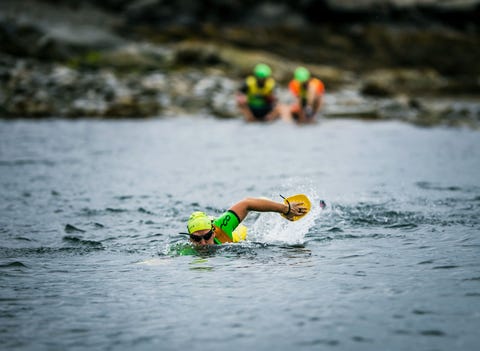
3. Maine – Odyssey SwimRun Casco Bay
Swim, run
The growing-in-the-U. S. sport of Swim Run should probably be called Swim Run Swim Run, because you do each more than once. In Casco Bay, you swim among seals in 60-degree water, then run across an island over trails, boulders, and pavement. You then swim to another island—in your shoes, no time for off/on—and so on for either 21-ish miles (about 17 running, four swimming) or 11-ish miles (about nine running, two swimming). It’s adventure plus agility, and the sport’s still small enough for you to feel like you’re part of an intrepid, supportive family during races. August 9; odysseyswimrun.com
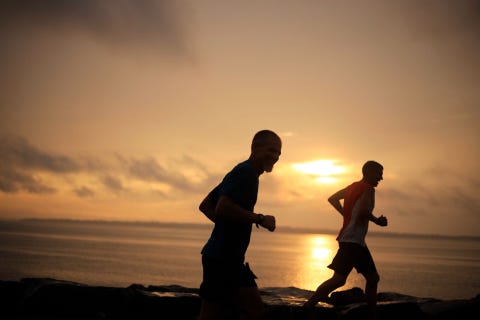
4. Rhode Island – Anchor Down Ultra
Run
What Rhode Island lacks in square footage it makes up for with some pretty dedicated ultramarathoners. These runners complete as many laps as possible in 24 hours on a 2.45-mile course through Bristol’s Colt State Park, along the shores of Narragansett Bay. The race starts at 7:00 p.m. and runs overnight and through the next day. If 24 hours sounds too mind-numbing, you can try the six- or 12-hour version of the same event. August 14 to 15; anchordownultra.com
5. Connecticut – Real Life Ninja Academy
Obstacle race, agility
Become a ninja warrior or just train like one at this gym founded by nine-time Ninja Warrior veteran Drew Drechsel. At three locations in Connecticut (and one on Long Island), you not only gain strength; you learn how to approach obstacles, mentally and physically. reallifeninjaacademy.com
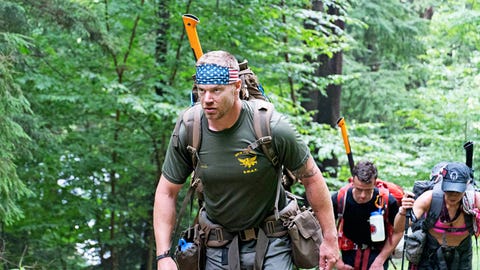
Courtesy Spartan / Marion Abrams
6. Vermont – The Spartan Farm Obstacle race
Obstacle race
Pittsfield is home to Spartan Race founder Joe De Sena’s farm, where ultra high-performing athletes are invited to train, work, team-build, and “play” alongside De Sena and other Spartans. It’s also home to the infamous Death Race—a 72-hour endurance test that can involve trekking through rivers, chopping and carrying wood, and solving mental puzzles. But you don’t have to be a Death Racer to forge extreme resilience and strength. Start with burpees. “I live by these,” De Sena says. His challenge to you: 50 good burpees a day, minimum, along with your usual conditioning routine. spartan.com


.

7. Wisconsin – American Birkebeiner
Cross-country ski
America’s largest cross-country ski race—the “Birkie,” part of the Worldloppet circuit of 20 international ski marathons— accommodates amateurs and elites in the classic and skate options. It’s like the New York City Marathon of cross-country racing, with more than 10,000 participants and even more spectators, who infiltrate the small, sawmill-turned-skiing town of Hayward each year. February 22; birkie.com
8. Indiana – Breathe Festival
Slackline, yoga, meditate
Slacklining—walking across a two-inch-wide strap several feet off the ground—started out as something climbers did to sharpen their focus and balance during downtime. It’s evolved into a discipline all kinds of athletes practice, and now there’s even a major slacklining festival. It’s not a competition, per se, but there will be plenty of stretching your skills. At Breathe, a four-day festival in Spencer, you and about 800 other balancers can slackline—doing pretty much anything on it, like yoga—and train to be an instructor. Since its founding in 2014, Breathe has also come to include meditation, paddleboarding, acro-yoga, and drumming. July 9 to 12; discoverbreathe.com
9. Iowa – RAGBRAI
Road ride
In any conversation about biking in the Midwest, the Register’s Annual Great Bicycle Ride Across Iowa will come up, probably regarding someone who’s been doing the multiday ride across Iowa for dozens of years. RAGBRAI will enter its 48th year in 2020, making it the oldest—and the largest and longest—multiday recreational bicycle touring event in the world. The ride rolls through the smallest towns in the state. “It’s the people and the towns that deliver Iowa hospitality that make RAGBRAI so special,” says director T. J. Juskiewicz. About 20,000 people ride each day; up to 35,000 come out for several of the seven stages. Be ready to ride “lots of ten- to 12-mile segments with 45 minutes off the bike at each stop for pork chops, beer, or homemade pie,” says Juskiewicz. July 19 to 25; ragbrai.com
10. Kansas – Dirty Kanza
Gravel ride
Riding on gravel is less predictable than on tarmac, and it turns your forearms, quads, and mind to mush a little faster. That makes actually finishing Dirty Kanza even more rewarding. Starting in Emporia, it’s 200 miles of punishing climbs and tricky descents in the Flint Hills, followed by grinding across tallgrass prairie for miles and miles and miles. Fast riders finish in about ten hours, slower ones in 20-plus. Only 18 completed the inaugural race in 2006, but the event now draws about 3,000 participants, who choose to go 25, 50, 100, 200, or 350 miles. May 28 to 30; dirtykanza.com

Cindy Hiles
11. Missouri – MR340
Kayak, canoe, paddleboard, pedal boat
The Missouri American Water 340 is an endurance boat race across the state. “Competitors will start in Kansas City and finish—some of them, anyway—in St. Charles,” so say the event organizers. You choose your vessel—kayak, canoe, paddleboard, surf-ski, or pedal boat—and have 88 hours to cover all 340 miles on the Missouri River. Sometimes scenic, sometimes lonely—certain sections are incredibly isolated—but always epic. Only two thirds of last year’s 550 teams finished in time. August 4 to 7; rivermiles.com/mr340
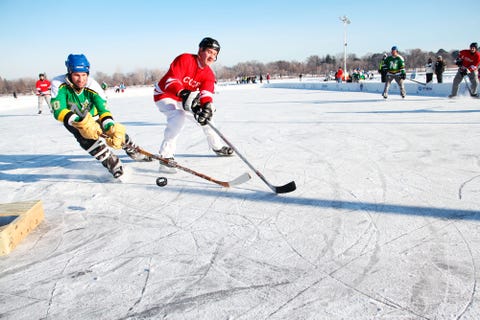
12. Minnesota – U. S. Pond-Hockey Championships
Ice hockey
About 300 teams with names like Here for the Beer and the Mighty Drunks take to the 27 rinks on Lake Nokomis, a few miles outside Minneapolis, to play 30-minute games over three days. There are divisions for everyone—the open division often includes retired pros, while the Rink Rat division is for people “who have the heart of a true pond fanatic but may not have the skills to take on former NHL players.” No slap shots or checking—or goalies. You shoot the puck through a slot in a wooden box. When players aren’t on the ice, they gather in a huge warming tent to talk hockey and mullets over ice-cold Labatts. January 23 to 25; uspondhockey.com
13. Michigan – M22 Challenge
Run, bike, paddle
This run-bike-paddle challenge calls itself “the most beautiful race in America,” but it’s not a leisurely trip through the scenery. It starts with a 2.5-mile dash over sand dunes at Sleeping Bear Dunes. Then you mount your bike for a 17-mile ride on one of Michigan’s classic scenic bike routes and finish with a 2.5-mile paddle via kayak, stand-up paddleboard, or surf-ski boat. M22 competitors warn you to pace yourself, especially at the start—this race is often won or lost on the water. June 13; m22challenge.com


.
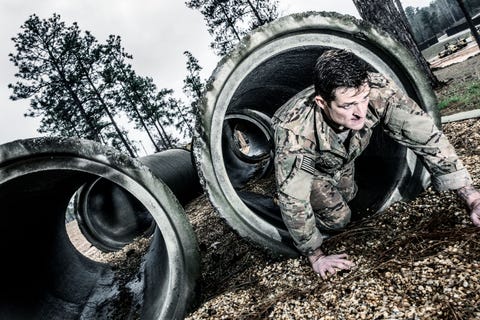
14. Georgia – Best Ranger Competition
Run, obstacle course
The Rangers are among the fittest soldiers in the armed forces. One small piece of their annual fitness and tactical-skills competition at Fort Benning involves a one-mile assault course with 22 obstacles. Think swampy, humid Georgia heat and obstacles like a 33-foot rope-and-ladder climb, a weighted carry, and a pond swim, and that’s just before noon. For three days in April, they test their agility, fitness, and mental prowess against two-person teams from other branches of the military until the winners are declared. April 17 to 19; bestrangercompetition.com
15. North Carolina – Highland Games
Caber toss, run
An estimated 30,000 people turn up in Linville for this celebration of Scottish and Celtic culture that includes not just a whisky tasting to start but also the caber toss (throwing a log the size of a telephone pole), the sheaf toss (throwing a 16-pound sack of hay over a 20-foot-high bar), and highland wrestling. The run up Grandfather Mountain—five miles, to 5,000 feet above sea level, aptly named the Bear—attracts 800 runners and regularly has a wait list of around 350 people. July 9 to 12; gmhg.org
16. Oklahoma – U. S. Rowing National High Performance Center Row
Row
The center is an official U. S. Olympic & Paralympic Training Site, the only USOC site in the country for rowing. If you’re not an Olympic hopeful, you can still row like a pro. Competition distance for Olympians is 2,000 meters, so you don’t just go hard and fast—you go hard and fast for about six minutes. To get there (or at least get closer), listen to head coach Reilly Dampeer: Figure out the max average watts you can hold for 60 seconds. Then, over the next four weeks, do two hard rower (“erg”) workouts a week. One should be shorter, harder intervals, hitting 65 percent of your max average watts; another should be longer intervals, where you hold 50 percent of your average. riversportokc.org
17. Virginia – Blue Ridge Marathon Run
Run
If you want to spend more time on the iconic Blue Ridge Parkway, which cuts through the Blue Ridge Mountains, break free from your car and run it. Called America’s Toughest Road Marathon, this race starts in Roanoke and involves 7,430 feet of climbing, including multiple switchbacks, as you ascend Roanoke Mountain and earn views of the surrounding valleys. Don’t expect a PR. The motto is “Just finish,” and if you go slower than 16 minutes per mile, you will be pulled. April 18; blueridgemarathon.com


.
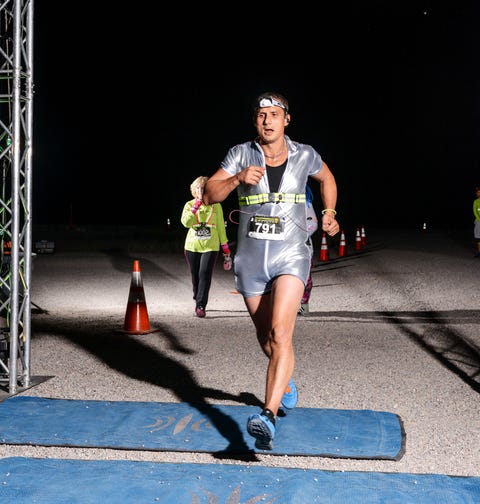
18. Nevada – ET Midnight Marathon Run
Run
Runners join UFO enthusiasts and nature lovers along Area 51, the special stretch of Highway 375 that’s home to a huge number of UFO sightings (so many that the highway itself is called the Extraterrestrial Highway). The marathon starts at midnight on the August weekend closest to the full moon. If you think a full marathon—it’s a Boston Qualifier—would have you wishing to be teleported to another planet, you can do a half marathon, 10K, or 5K. August 1; calicoracing.com
19. Montana – Sentinel Hill Climb Run
Run
Yes, it’s 1.5 miles uphill. And 2,000 feet of elevation. But hey, there’s ice cream at the end. Plus bragging rights. This takes place on the most popular trail on Mount Sentinel but goes past the concrete M—a University of Montana icon that most people don’t climb beyond. Switchbacks get you to this landmark, then it’s straight uphill to the summit for the last 1,200 feet. Organizers invite you to “run, walk, hike, or crawl your way up.” This year’s winner finished in 20:50.95. May 6; runnersedgemt.com/events/hillclimb
20. North Dakota – Maah Daah Hey Trail
Mountain Bike
Runners dream of racing in the Boston Marathon, and golfers of teeing off at Pebble Beach. Horse packers and mountain bikers fantasize about riding North Dakota’s Badlands. The classic route is the 144-mile Maah Daah Hey Trail singletrack, which winds through Little Missouri National Grasslands and includes the popular/scary Devils Pass descent (narrow!). ”It’s like you are in two different locations at the same time, a miniature Grand Canyon with scorched, barren earth on one side and lush, green prairie grass and juniper trees on the other,” says Nick Ybarra, a mountain-bike guide with Experience Land. “You can ride the entire trail and not see another person.” mdhta.com
21. Oregon – Hood to Coast Relay Run Run
Run
The largest relay in the world—12,600 runners last year—starts at Mount Hood and finishes on the Oregon coast, some 200 miles away. Every 12-member team is divided into two vans, and each member runs three legs of the 36-leg race. Hood to Coast is equal parts relay race, slumber party, and road trip. Runners take about four- to eight-mile shifts around the clock, and it’s the connections you make on the road, and on the beach at the after-party, that stay with you forever. August 28 to 29; hoodtocoastrelay.com
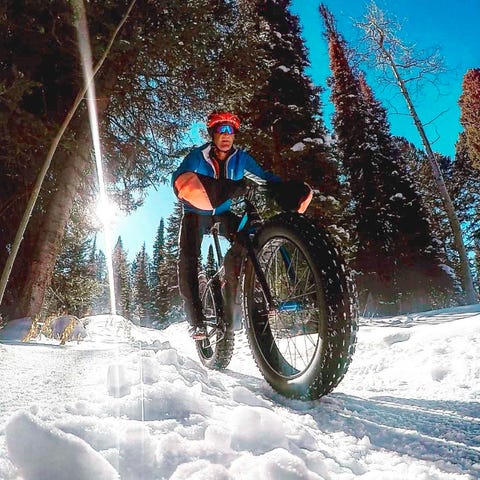
22. Wyoming – Grand Targhee Resort Fat Bike Night Fat-tire bike
Fat-tire bike
In Alta, it’s already night at 5:30 in the colder months, and that’s the start time for this fat-tire-bike race. Grand Targhee was the first U. S. resort to embrace fat-tire bikes on the cross-country-trail system, and up to 50 riders line up for this race—of one or two eight-mile laps—each year. December 7; grandtarghee.com
23. Washington RAMROD (Ride Around Mount Rainier in One Day) Bike
Bike
Only 800 riders win a lottery slot into the Pacific Northwest’s premier cycling event, and there’s lots of devastation among those who don’t. Riders begin this 150-mile ride around the iconic mountain with a gradual downhill from the town of Enumclaw. Then the ride really starts. Rolling hills lead the way to a 12-mile ascent to Inspiration Point, a nine-mile trip up Cayuse Pass, and a downhill to complete this challenging ride (10,000 feet in elevation). Leaders finish in eight or nine hours. More-relaxed riders linger at the aid stations, especially the one halfway up the lonely climb to Cayuse. July 30; redmondcyclingclub.org
Source: Read Full Article
